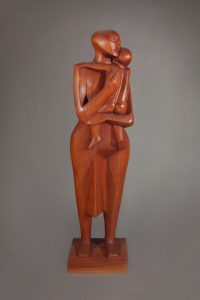
Elizabeth Catlett (American, 1915–2012), Mother and Child, 1983, Mahogany, 53 x 13 x 13 in., Museum purchase, Women’s Volunteer Committee Fund, 83.71
[Update, February 2023: Following the installation of Elizabeth Catlett’s Woman and Child in NOMA’s Great Hall, the sculpture is on view in the George l. Viavant Gallery on the museum’s second floor.]
When artist and activist Elizabeth Catlett lived in New Orleans in the early 1940s, much of the city was racially segregated, including City Park—and, by extension, the New Orleans Museum of Art. As the chair of the art department at Dillard University from 1940 to 1942, Catlett was determined that her students should have the same access to art as their white peers. She defied segregation orders to arrange for her students to visit the Isaac Delgado Museum (now NOMA) to view an exhibition of Pablo Picasso’s paintings. For most of them, it was their first time in an art museum.
Newly placed in NOMA’s Great Hall, Catlett’s sculpture Mother and Child honors the artist’s lifelong history of protest, and her commitment to fighting racism, injustice, and systemic abuses of power. Throughout her career, Catlett created art in solidarity with the Civil Rights and Black Power movements, focusing specifically on widely underestimated role of Black women in these struggles. Catlett’s sculptures—whether carved in wood, chiseled in stone, or carved in clay—show Black women as mothers, leaders, teachers, and survivors. Carved in mahogany, the lines of Catlett’s Mother and Child follow the ripple of the wood’s grain, making this woman feel at once monumental and timeless, and also of the earth and the present moment. From the universal gesture of a mother embracing her child, which Catlett began working with in the 1940s, the artist would continue to find imagery to fuel a revolution, reminding us of the role that art can play in the fight for social justice. As Catlett once proclaimed, “We have to create an art for liberation and for life.”
In NOMA’s Great Hall, Mother and Child serves as a marker of NOMA’s commitment to examine its own history, a reminder of our accountability to our community, and an expression of our solidarity with all those across the world seeking justice today. It represents only a beginning: the start of a renewed effort to honestly tell NOMA’s story, take account of our present work, and to listen to our community as we work towards change.
—Katie Pfohl, Curator of Modern and Contemporary Art